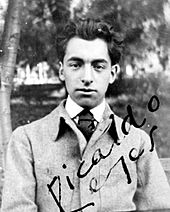Pablo Neruda facts for kids
Quick facts for kids
Pablo Neruda
|
|
|---|---|
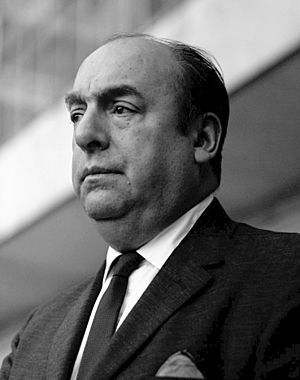
Neruda in 1963
|
|
| Born |
Ricardo Eliécer Neftalí Reyes Basoalto
12 July 1904 Parral, Maule Region, Chile
|
| Died | 23 September 1973 (aged 69) Santiago, Chile
|
| Occupation |
|
| Political party | Communist Party |
| Spouse(s) |
|
| Children | 1 |
| Awards |
|
| Signature | |
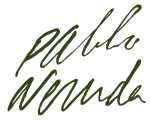 |
|
Pablo Neruda (born Ricardo Eliécer Neftalí Reyes Basoalto; 12 July 1904 – 23 September 1973) was a famous Chilean poet-diplomat and politician. He won the 1971 Nobel Prize in Literature for his amazing poems.
Neruda started writing poetry when he was just 13 years old. He wrote in many different styles. Some of his poems were dream-like (called surrealist poems). Others were long historical stories or passionate love poems. One of his most famous collections is Twenty Love Poems and a Song of Despair (1924).
He also worked as a diplomat for Chile in many countries. He even served as a Senator for the Chilean Communist Party. In 1948, the government made communism illegal. An arrest warrant was issued for Neruda. Friends helped him hide for months. In 1949, he escaped over the Andes Mountains into Argentina. He did not return to Chile for over three years.
Neruda was a close friend and advisor to Chile's President Salvador Allende. After winning his Nobel Prize in 1971, Neruda returned to Chile. President Allende invited him to read his poems to 70,000 people.
In September 1973, Neruda was in the hospital with cancer. This was when a military takeover (called a coup d'état) happened in Chile. The military, led by Augusto Pinochet, overthrew Allende's government. Neruda went home from the hospital after a few days. He suspected a doctor might try to harm him.
Neruda died at his home on 23 September 1973. For a long time, people thought he died of heart failure. However, later investigations suggested he might have been killed. In 2023, scientists found a type of bacteria in his body. This bacteria can produce toxins. It is thought it might have been injected while he was in the hospital.
Neruda is often called the national poet of Chile. His works are popular and have influenced people all over the world. Many famous writers have praised his poetry.
Contents
His Early Life and First Poems
Ricardo Eliécer Neftalí Reyes Basoalto was born on 12 July 1904. He was born in Parral, Chile, a city about 350 km south of Santiago. His father worked for the railway. His mother was a school teacher, but she died two months after he was born.
Neruda grew up in Temuco. He started writing his first poems in 1914. His father did not want him to be a writer. But others encouraged him, including Gabriela Mistral. She was a famous poet who also won the Nobel Prize.
On 18 July 1917, when he was 13, he published his first essay. It was called "Enthusiasm and Perseverance." He signed it "Neftalí Reyes." From 1918 to 1920, he published many poems and essays. In 1920, he started using the name Pablo Neruda. He might have chosen it from a Czech poet named Jan Neruda.
Becoming a Famous Poet
In 1921, at age 16, Neruda moved to Santiago. He planned to study French and become a teacher. But he spent most of his time writing poems. He met a publisher named Don Carlos George Nascimento.
In 1923, his first book of poems, Crepusculario (Book of Twilights), was published. The next year, he published Veinte poemas de amor y una canción desesperada (Twenty Love Poems and A Desperate Song). Both books were very popular. They have been translated into many languages. Twenty Love Poems is still the best-selling poetry book in Spanish. By age 20, Neruda was famous, but he was also very poor.
In 1927, because he needed money, he became a diplomat. He worked as a consul in places like Rangoon (Burma), Colombo (Sri Lanka), and Batavia (Java). While working as a diplomat, he read many poems and tried different writing styles. He wrote the first two books of Residencia en la Tierra, which included many surrealist poems.
Diplomat and Politician
After returning to Chile, Neruda worked as a diplomat in Buenos Aires and then in Barcelona, Spain. Later, he became consul in Madrid. There, he became friends with other famous writers like Federico García Lorca.
Neruda had one daughter, Malva Marina, born in Madrid in 1934. She had serious health problems. Neruda later separated from his first wife and began a relationship with Delia del Carril.
Spanish Civil War and Political Views
When the Spanish Civil War began, Neruda became very interested in politics. He became a strong supporter of Communism. This was partly because his friends were left-wing. But a big reason was that García Lorca was killed by forces loyal to the dictator Francisco Franco. Neruda supported the Spanish Republic through his writings. He published a collection called España en el corazón (Spain in Our Hearts, 1938). He lost his job as consul because of his strong political views.
In 1938, Pedro Aguirre Cerda became President of Chile. Neruda supported him. The President then made Neruda a special Consul in Paris. His job was to help 2,000 Spanish refugees. These refugees were living in bad camps in France. Neruda helped them travel to Chile on an old ship called the Winnipeg.
Time in Mexico
Neruda's next diplomatic job was in Mexico City from 1940 to 1943. While there, he married Delia del Carril. He also learned that his daughter Malva had died in the Netherlands.
In 1943, Neruda returned to Chile. He visited Machu Picchu in Peru. This trip inspired him to write Alturas de Macchu Picchu. This long poem explored the ancient civilizations of the Americas. He continued this theme in his book Canto General (1950). In these poems, he celebrated the achievements of ancient cultures. But he also spoke out against the slavery that made them possible.
Joining the Communist Party
Neruda admired the Soviet Union and Joseph Stalin because of their role in defeating Nazi Germany. He wrote poems praising Stalin. In 1953, Neruda received the Stalin Peace Prize. He also wrote poems praising other leaders like Fidel Castro.
On 4 March 1945, Neruda was elected a Senator for northern Chile. He officially joined the Communist Party of Chile four months later. In 1946, he helped Gabriel González Videla become president. But once in office, González Videla turned against the Communist Party. He passed a law that made communism illegal.
Neruda strongly criticized President González Videla. In January 1948, he gave a famous speech in the Chilean senate called "Yo acuso" ("I accuse"). In this speech, he named miners and their families who were put in a concentration camp.
Hiding and Exile
A few weeks after his "Yo acuso" speech, Neruda was in danger of being arrested. He went into hiding. Friends and supporters helped him move from house to house for 13 months. He was removed from his job as Senator. In September 1948, the Communist Party was completely banned.
Neruda's time in hiding ended in March 1949. He escaped over the Andes Mountains into Argentina on horseback. He later told the story of his escape in his Nobel Prize speech.
He spent the next three years in exile. In Buenos Aires, he used a friend's passport to travel to Europe. Pablo Picasso helped him get into Paris. Neruda surprised everyone by appearing at a peace conference there. The Chilean government had said he could not have escaped.
During his exile, Neruda traveled a lot. He went to Europe, India, China, and the Soviet Union. In Mexico, he met a Chilean singer named Matilde Urrutia. They started a relationship. She traveled to meet him whenever she could. Matilde Urrutia became the inspiration for his poetry book Los versos del capitán, which he published without his name in 1952.
While in Mexico, Neruda also published his long poem Canto General. This poem describes the history, geography, and nature of South America. He wrote much of it while he was in hiding. He even carried the manuscript with him during his escape.
Return to Chile and Later Years
By 1952, the government in Chile was weak. Neruda returned to Chile in August 1952. He rejoined Delia del Carril, but their marriage was ending. She found out about his relationship with Matilde Urrutia. Neruda and Urrutia eventually married in 1966. From then on, Neruda mostly lived in Chile, except for trips abroad and a time as ambassador to France.
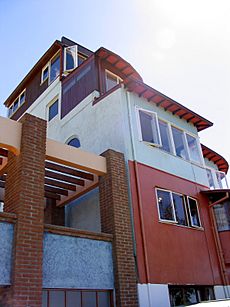
By this time, Neruda was famous worldwide. His books were translated into almost every major language. He often spoke out against the United States, especially during the Cuban Missile Crisis and the Vietnam War. Because he was a well-known left-wing writer, he also faced opposition. Some groups tried to damage his reputation.
In 1966, Neruda was invited to a conference in New York City. At first, he was not allowed into the U.S. because he was a communist. But the conference organizer, Arthur Miller, convinced the government to give him a visa. Neruda read his poems to large crowds.
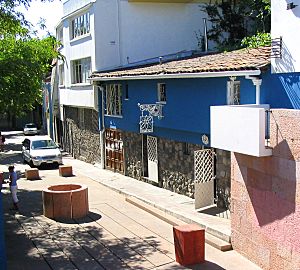
In 1970, Neruda was a candidate for president of Chile. But he decided to support Salvador Allende instead. Allende won the election and became Chile's first democratically elected socialist president. Soon after, Allende made Neruda the Chilean ambassador to France. This was his last diplomatic job. While in Paris, Neruda helped Chile with its debts to European and American banks. But his health began to get worse. He returned to Chile in 1972 because of his health.
In 1971, Neruda received the Nobel Prize in Literature. This was a big honor. In his speech, he said that a poet is both a force for togetherness and for being alone.
His Final Days and Death
In 1973, Neruda was diagnosed with prostate cancer. The military takeover led by General Augusto Pinochet destroyed Neruda's hopes for Chile. Soon after the coup, soldiers searched Neruda's house. He famously told them: "Look around – there's only one thing of danger for you here – poetry."
It was first reported that Neruda died of heart failure on 23 September 1973. He was in a clinic in Santiago. However, his former driver, Manuel Araya Osorio, said that Neruda called his wife and told her he believed Pinochet had ordered a doctor to kill him. He said he had just been given an injection. He died a few hours later.
In 2015, the Chilean government said it was "clearly possible and highly likely" that Neruda was killed. In 2023, scientists found bacteria in his body that can produce toxins. This supported the idea that he might have been poisoned. Neruda was supposed to fly to Mexico. His friends thought he might have been planning to lead a government in exile against Pinochet.
His funeral took place with many police present. People at the funeral used the chance to protest against the new military government. Neruda's house was broken into, and his papers and books were destroyed.
In 1974, his book of memories, I Confess I Have Lived, was published. It included details up to his last days. His wife, Matilde Urrutia, later put together and published his memoirs and possibly his last poem. She also wrote her own book, My Life with Pablo Neruda.
His Legacy
Neruda owned three houses in Chile. Today, they are all museums open to the public. They are La Chascona in Santiago, La Sebastiana in Valparaíso, and Casa de Isla Negra in Isla Negra. Neruda and Matilde Urrutia are buried at Isla Negra.
A statue of Neruda stands at the Organization of American States building in Washington, D.C.
List of Works
Original Books
- Crepusculario. Santiago, 1923.
- Veinte poemas de amor y una canción desesperada. Santiago, 1924.
- Tentativa del hombre infinito. Santiago, 1926.
- Anillos. Santiago, 1926. (With Tomás Lago.)
- El hondero entusiasta. Santiago, 1933.
- El habitante y su esperanza. Novel. Santiago, 1926.
- Residencia en la tierra (1925–1931). Madrid, 1935.
- España en el corazón. Santiago, 1937.
- Nuevo canto de amor a Stalingrado. México, 1943.
- Tercera residencia (1935–1945). Buenos Aires, 1947.
- Alturas de Macchu Picchu. Santiago de Chile, 1948.
- Canto general. México, 1950.
- Los versos del capitán. 1952.
- Todo el amor. Santiago, 1953.
- Las uvas y el viento. Santiago, 1954.
- Odas elementales. Buenos Aires, 1954.
- Nuevas odas elementales. Buenos Aires, 1955.
- Tercer libro de las odas. Buenos Aires, 1957.
- Estravagario. Buenos Aires, 1958.
- Navegaciones y regresos. Buenos Aires, 1959.
- Oda al Gato, original poem in Navegaciones y regresos book.
- Cien sonetos de amor. Santiago, 1959.
- Canción de gesta. La Habana, 1960.
- Poesías: Las piedras de Chile. Buenos Aires, 1960.
- Cantos ceremoniales. Buenos Aires, 1961.
- Memorial de Isla Negra. Buenos Aires, 1964. (5 volumes.)
- Arte de pájaros. Santiago, 1966.
- Fulgor y muerte de Joaquín Murieta. Santiago, 1967. (Written for an opera.)
- La Barcarola. Buenos Aires, 1967.
- Las manos del día. Buenos Aires, 1968.
- Comiendo en Hungría. Barcelona, 1969. (With Miguel Ángel Asturias.)
- Fin del mundo. Santiago, 1969.
- Aún. Santiago, 1969.
- Maremoto. Santiago, 1970.
- La espada encendida. Buenos Aires, 1970.
- Las piedras del cielo. Buenos Aires, 1970.
- Discurso de Estocolmo. Alpignano, Italia, 1972.
- Geografía infructuosa. Buenos Aires, 1972.
- La rosa separada. París, 1972.
- Incitación al Nixonicidio y alabanza de la revolución chilena. Santiago, 1973.
English Translations
- The Heights of Macchu Picchu (bilingual edition) (1966)
- Selected Poems: A Bilingual Edition, translated by Nathaniel Tarn. (1970)
- The Captain's Verses (bilingual edition) (1972)
- New Poems (1968-1970) (bilingual edition) (1972)
- Residence on Earth (bilingual edition) (1973)
- Extravagaria (bilingual edition) (1974)
- Selected Poems.(translated by Nathaniel Tarn: 1975)
- Twenty Love Poems and a Song of Despair (bilingual edition) (1976)
- Still Another Day (1984, 2005)
- The Separate Rose (1985)
- 100 Love Sonnets (bilingual edition) (1986)
- Winter Garden (1987, 2002)
- The Sea and the Bells (1988, 2002)
- The Yellow Heart (1990, 2002)
- Stones of the Sky (1990, 2002)
- Selected Odes of Pablo Neruda (1990)
- Canto General (1991)
- The Book of Questions (1991, 2001)
- The Poetry of Pablo Neruda, an anthology of 600 of Neruda's poems. (2003, 2005)
- 100 Love Sonnets (bilingual edition) (2004, new edition 2016)
- On the Blue Shore of Silence: Poems of the Sea (2004)
- The Essential Neruda: Selected Poems (2004)
- Intimacies: Poems of Love (2008)
- The Hands of the Day (2008)
- All The Odes (2013)
- Then Come Back: The Lost Neruda (2016)
- Venture of the Infinite Man (2017)
- Book of Twilight (2018)
Images for kids
-
Neruda with his wife and Erich Honecker in 1951
See also
 In Spanish: Pablo Neruda para niños
In Spanish: Pablo Neruda para niños


